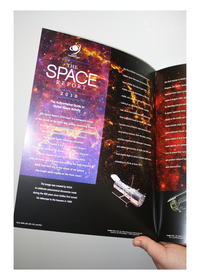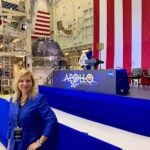Spotlight
The Space Report: Commercial Human Spaceflight
Written by: developer
 The following information – and much more about developments in the space industry can be found in The Space Report 2010: The Authoritative Guide to Global Space Activity. To order a copy in book, PDF, or CD-ROM format, go to www.TheSpaceReport.org.
The following information – and much more about developments in the space industry can be found in The Space Report 2010: The Authoritative Guide to Global Space Activity. To order a copy in book, PDF, or CD-ROM format, go to www.TheSpaceReport.org.
In late October 2010, a ceremony was held to mark the completion of a runway measuring nearly two miles at Spaceport America in New Mexico. The rest of the spaceport is scheduled for completion in 2011, with the expectation that commercial operations will begin shortly thereafter.
Development of commercial human spaceflight capabilities is evolving along two tracks, suborbital and orbital. Several ventures are actively developing vehicles capable of suborbital human spaceflight, with tests of some flight systems having already begun in 2010. The best known of these ventures, Virgin Galactic, began test flights of its WhiteKnightTwo carrier aircraft in 2008. SpaceShipTwo, the suborbital vehicle that will launch from WhiteKnightTwo, was unveiled in December 2009 and has undergone glide tests this year. Virgin Galactic’s initial commercial flights will be conducted from Spaceport America in New Mexico. The company also has plans to conduct flights from Sweden and the United Arab Emirates. Virgin Galactic currently has 300 customers signed up to fly on suborbital flights, and has received $42 million in deposits from those customers.
Several other companies are in various stages of the development of suborbital vehicles. XCOR Aerospace is developing the Lynx space plane, capable of carrying one pilot and one passenger on suborbital flights. The company completed wind tunnel tests of the spacecraft at NASA’s Marshall Space Flight Center in September 2010. XCOR will operate the Lynx from the United States and has signed an agreement to lease a Lynx vehicle to the Yecheon Astro Space Center in South Korea.
Other U.S. companies actively developing suborbital vehicles for human spaceflight include Armadillo Aerospace based in Rockwall, Texas, Blue Origin of Seattle, Wash., and Masten Space Systems in Mojave, Calif. Both Masten and Armadillo have won elements of the Northrop Grumman Lunar Lander X PRIZE Challenge. The competition, which is also financially supported by NASA’s Centennial Challenges program, sets technical goals that simulate lunar landings to develop new technologies. The objective is to identify innovative solutions and support private sector partners that could ultimately provide NASA with commercial and mission support. During 2009, Masten won two awards with a total value of $1,150,000, while Armadillo won $500,000 in 2009 and $350,000 in 2008. Both companies are continuing to develop their systems. Armadillo is also working on separate projects such as its Bridenstine DKNY Rocket Racer and suborbital vehicle with the initial goal of flying to altitudes of 100,000 feet and higher within 2010.
U.S. companies are not alone in pursuing commercial orbital human spaceflight. Excalibur Almaz, based on the Isle of Man in the Irish Sea, announced plans in August 2009 to begin commercial human orbital missions in 2013 using the Almaz reusable capsule developed in Russia in the 1970s. The company owns several of the three-passenger Almaz spacecraft, and plans to use the Russian Proton vehicle to conduct launches. The company plans to fly the Almaz spacecraft on missions of up to a week for tourism and research.
This article is part of Space Watch: November 2010 (Volume: 9, Issue: 11).


